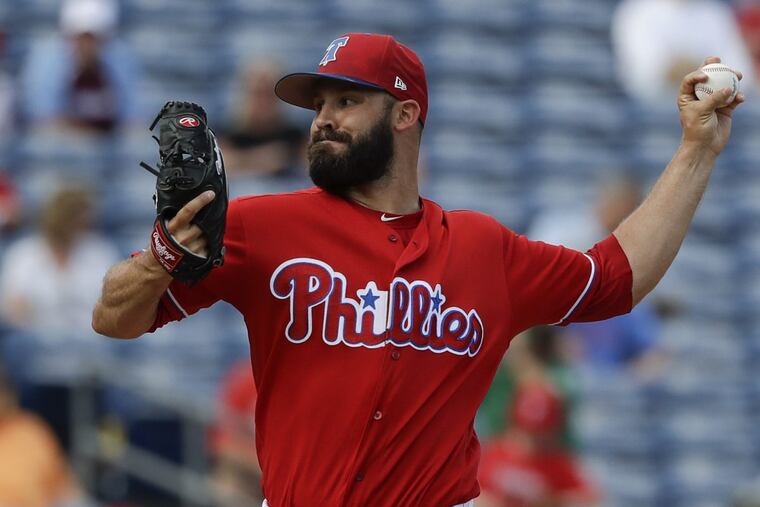Adam Morgan gets chance to restart career with Phillies | Mike Sielski
The lefty wasn't much of a starter for the Phils, but as a reliever, he has a chance to be exactly what every team needs: a pitcher who can strike out hitters late in games.

DUNEDIN, Fla. — Adam Morgan has the beard necessary to be a dominant relief pitcher. It is brown and fuzzy and full around his mouth, and it would place him on that long continuum of closers and setup men who grew and groomed their facial hair to fit their personae and, maybe, to send a message. From Rollie Fingers' tip-twirled mustache to the intimidating handlebars of Al Hrabosky and Rod Beck to the ink-black bush that covered Brian Wilson's lower jaw, the hair on a reliever's mug can make him appear a little different, a little arrogant and unconventional, a little … weird. And in a late-inning matchup with a game's outcome on the line, being weird, or just having the hitter think you're weird, can give you an edge.
"A lot of times people ask, 'What comes first, the success or the confidence?' " Morgan said. "You've got to have that confidence."
When he was a starting pitcher for the Phillies, Morgan would have taken any edge he could get. Over the 2015 and 2016 seasons, he started 36 of the 38 games in which he appeared, producing some unsightly results and revealing some hard truths. He went 7-18 with a 5.37 ERA and a 1.391 ratio of walks and hits to innings pitched, and his repertoire of pitches — particularly a fastball that hovered around 90 mph — kept opposing hitters as comfortable as they'd be in a pregame soft-toss drill. After he barely made the Phillies roster last season as a long man in the bullpen, he gave up seven earned runs over his first two appearances and was demoted to triple-A Lehigh Valley.
He returned to the Phillies for good in early June, and he returned a new man, a new pitcher. That he was still lefthanded seemed the only aspect of him that hadn't changed. Without having to consider facing a lineup more than once, Morgan became more aggressive in his approach. His average fastball velocity, according to the database and scouting firm Fangraphs, jumped to 94.1 mph, but he threw it less often. He began to think of his slider and change-up as strikeout pitches, especially against lefthanded hitters. From early August to late September, he struck out 32, walked just five, and posted a 0.69 ERA over a 20-game, 26-inning stretch. He had 63 strikeouts in 54 2/3 innings, an average of 10.37 per nine innings.
Such a remaking happens in baseball — Dennis Eckersley and Andrew Miller are perhaps the best and most well-known examples — but given how far from excellence Morgan had been, his was still striking. Somehow, he had transformed himself, or was at least on the way to transforming himself, into the kind of reliever major-league teams covet: the kind who, late in a game, misses bats. The fewer strikes a pitcher allows to be put into play, the less likely it is that the opposing team can score. There were no more just-get-it-over sliders for Morgan, no more thought about whether he should throw a particular pitch to a particular hitter in a particular situation to set him up for another pitch in another situation later in the game. He pitched more like a man with facial hair.
"You're just thinking, 'I'm not holding anything back. I'm not trying to set him up for the next time through,' " he said. "It's like, 'Look, I'm putting all the cards on the table right there. I'm not saving anything.' Usually, when lefties came up, I was just going to give them sliders — no chance for them to even hit a fastball. You're not saying, 'OK, let me get ahead with the fastball, and then I'll put him away with this.' It's like I can go out there and try to throw three strikeout sliders. Especially later in the game, you're not trying to set anybody up."
It would be surprising if Morgan did not have an important role for the Phillies this season, even if it is merely as a specialist used primarily to retire lefthanded hitters. The Phillies made improving their bullpen an offseason priority, spending $34.25 million to sign Tommy Hunter and Pat Neshek, and it's reasonable to think that Morgan, now that his mind is at ease about his future, can be as effective as he was last season, if not more so. He threw a scoreless inning Tuesday against the Tigers in his second appearance of the spring. He turned 28 the same day. That sounds late to start a major-league pitching career, or even to restart one. It doesn't have to be.
"Coming in knowing you're going to be in the bullpen is — I wouldn't say easier, but clearer and more relaxing," he said. "You're relaxed because you're saying, 'This is where I'm going to put my focus. This is where I'm going to put my effort and energy into being the best reliever I can be.' I don't think I'm in any position to say, 'I want to do this' or 'I want to do that.' I want to help this team win any way I can."